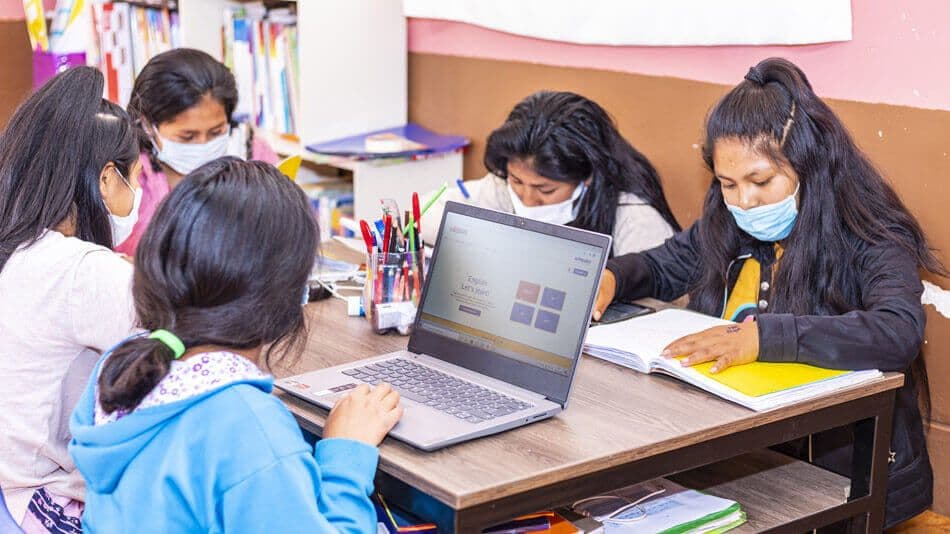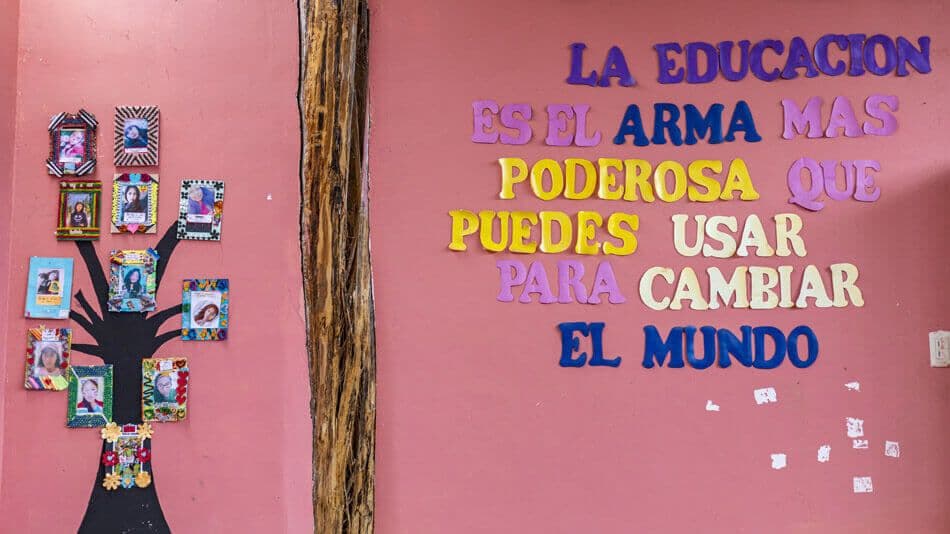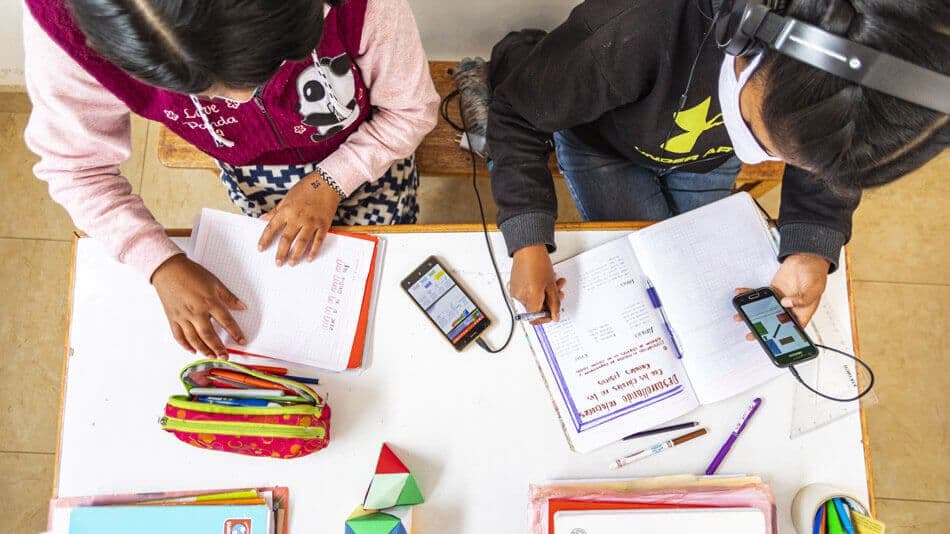A recipient of an F5 2021 Tech for Good Grant, Sacred Valley Project is purchasing 27 laptops to help indigenous girls in remote areas of Peru apply for university and study for college entrance exams.
The most remote areas of Peru are hours by foot from the nearest secondary school, making it difficult, if not impossible, for the children who live there to attend. Unfortunately, the situation is especially dire for girls from these rural Andean communities, the majority of whom never complete secondary school.
Primary schools in these remote areas are typically one-room classrooms with all five grade levels taught by the same teacher. And even if girls find a way to attend secondary school, they have an extremely hard time catching up to those educated in urban areas.
“Without access to education, many women will not talk above a whisper; cannot speak Spanish, the traditional language of commerce; and often cannot participate in community decisions,” says Christie Cutler, Sacred Valley Project’s development director. “Many become mothers as teenagers and experience severe domestic violence and alcoholism in their communities.”

Photo courtesy Diego Nishiyama
Moving Beyond the Poverty Cycle
To improve opportunities for marginalized indigenous girls from these remote areas, Sacred Valley Project was started in 2010 to help girls complete secondary school by providing dormitory-style housing and supplemental education.
The approximately 50 adolescent girls who take part in this program stay in one of two Sacred Valley Project dormitories throughout the school year, giving them just a 10- to 15-minute walk to and from school in the town of Calca. They receive after-school tutoring assistance to help them learn Spanish and catch up academically to their urban peers. They’re coached on reproductive health and women’s empowerment. And they get help planning their next steps after they graduate, whether that’s attending university, enrolling in a vocational school, or starting their own business.
By providing these services, Sacred Valley Project has been able to expand the opportunities available to these young women, helping them to break the cycle of teenage pregnancy and poverty. The nonprofit has maintained a 100% graduation rate over the past five years, with graduates going on to pursue careers in areas ranging from accounting to early childhood education to tourism and business administration.

Photo courtesy Diego Nishiyama
Education is the most powerful weapon that you can use to change the world.
““We know that educated women increase the economic growth potential of a community. They have a better chance of surviving childbirth, have smaller and healthier families, and can better cope with natural disasters and climate change.” ”
Bridging the Technology Gap
Yet while the program opens up new opportunities, the girls continue to face economic barriers after leaving secondary school. Most of these young women don’t have the necessary funds and school supplies they need to take the next step. And their families aren’t able to give them the financial support they need.
To help address this challenge, Sacred Valley Project obtained an F5 2021 Tech for Good Grant, which it is using to purchase 27 laptops for girls graduating from the program over the next three years. Given to each graduate as part of a larger scholarship package, these laptops will enable the girls to study for university entrance exams, apply for programs online, and pursue their post-secondary school studies.
“Without laptops, our students wouldn’t be able to access prep courses for entrance exams and college applications or study and complete their coursework,” says Cutler. “And especially in the age of COVID, which is not disappearing anytime soon from Peru, our students aren’t able to study or apply for college in person.”
In the past, Cutler says, Sacred Valley Project was primarily focused on providing the basics for the girls who attended the nonprofit’s program, from nutritious meals to a safe and nurturing home to the academic assistance they need. But when COVID struck, it increased the need for technology. “COVID has made our technology needs much more dire and really accentuated for us the disparities between those who have access to technology and those who don’t,” she says. “Our girls were completely excluded digitally from the resources so many had during this past remote learning year. To succeed, they really need access to their own computer.”

Photo courtesy Diego Nishiyama
Helping Girls Chart Their Future
The laptops will help Sacred Valley Project round out its services as it helps girls from rural Andean communities chart their future after they graduate and leave its dormitories. Already, the nonprofit has begun the design process for new housing to support graduates while they study for exams needed to enter university. It also plans to open a third dormitory in Paucartambo, adding another 20 students to its program.
With a $2 billion shortfall for girls’ education and 130 million girls out of school worldwide, Sacred Valley Project has been working to reverse these trends by providing quality services to the students it serves. “We know that educated women increase the economic growth potential of a community,” Cutler says. “They have a better chance of surviving childbirth, have smaller and healthier families, and can better cope with natural disasters and climate change. It’s heart-warming to see lives change as a result of our program—as girls see the options expand for themselves and for their own future.”
About F5 Tech for Good
At F5, we are committed to extending our purpose, reach, and connections beyond the walls of our own company by using our expertise to support nonprofit organizations with their digital transformation efforts. Our Tech for Good Grants help nonprofits update their technological resources, making it possible for them to streamline administrative efforts, improve data security, and—most importantly—expedite their missions so they can do even more to help those they serve.
Want to be notified when applications open for F5’s 2022 Tech for Good Grants? Sign up here to be added to the email list.
To learn more, see our previous blog posts, “Using Tech for Social Good” and “Helping New Mothers Stay Connected During the COVID-10 Pandemic.”
About the Author
Related Blog Posts

Architecting for AI: Secure, scalable, multicloud
Operationalize AI-era multicloud with F5 and Equinix. Explore scalable solutions for secure data flows, uniform policies, and governance across dynamic cloud environments.

Rein in API sprawl with F5 and Google Cloud
Find out how F5 and Google Cloud can help you secure and manage your ever-increasing API integrations.

Nutanix and F5 expand successful partnership to Kubernetes
Nutanix and F5 have a shared vision of simplifying IT management. The two are joining forces for a Kubernetes service that is backed by F5 NGINX Plus.

AppViewX + F5: Automating and orchestrating app delivery
As an F5 ADSP Select partner, AppViewX works with F5 to deliver a centralized orchestration solution to manage app services across distributed environments.
F5 NGINX Gateway Fabric is a certified solution for Red Hat OpenShift
F5 collaborates with Red Hat to deliver a solution that combines the high-performance app delivery of F5 NGINX with Red Hat OpenShift’s enterprise Kubernetes capabilities.
Phishing Attacks Soar 220% During COVID-19 Peak as Cybercriminal Opportunism Intensifies
David Warburton, author of the F5 Labs 2020 Phishing and Fraud Report, describes how fraudsters are adapting to the pandemic and maps out the trends ahead in this video, with summary comments.